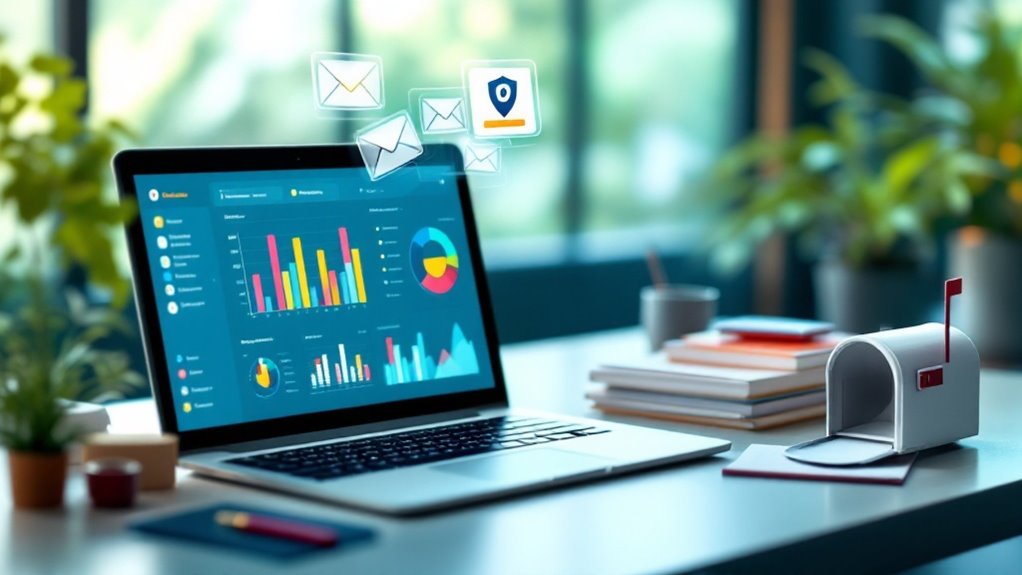Several reliable free bulk email marketing services offer essential features for small businesses and startups. Popular options include Brevo (300 daily emails), Sender (15,000 monthly emails), and Mailchimp (2,500 monthly emails). These platforms provide customizable templates, list management tools, basic automation, and analytics tracking. Key capabilities typically include audience segmentation, mobile-friendly designs, and CAN-SPAM compliance features. Understanding each platform’s specific limitations and capabilities helps determine the best fit for specific marketing needs.
Quick Overview
- Brevo offers the highest daily free email limit with 300 emails and unlimited contacts, plus comprehensive CRM capabilities.
- Sender provides generous free-tier service with 15,000 monthly emails for up to 2,500 subscribers and unlimited automation features.
- Mailchimp’s free plan includes 2,500 monthly emails for 500 contacts with AI-powered insights and e-commerce integration tools.
- Free bulk email services typically include customizable templates, list management, basic automation, and built-in analytics features.
- Successful bulk email campaigns require mobile-friendly design, clear calls-to-action, and compliance with anti-spam regulations.
Understanding Free Bulk Email Marketing Tools

Many businesses are discovering the power of free bulk email marketing tools as essential components of their digital marketing strategy. These platforms offer a robust set of features that help organizations effectively reach their target audiences through email campaigns. Users can launch their first campaign in just 15 minutes with intuitive tools and templates.
Free bulk email services typically include customizable templates, list management capabilities, and basic automation workflows. Users can track campaign performance through built-in analytics and reporting features, while maintaining compliance with anti-spam regulations. Most platforms also integrate smoothly with other marketing tools, making them versatile additions to existing business systems.
While these tools provide significant value, users should be aware of common limitations. Free versions often restrict daily email volumes, cap subscriber list sizes, and include service provider branding. However, for small businesses and startups, these limitations are usually outweighed by the benefits of cost-effective email marketing solutions.
Top Providers and Their Free Service Offerings
When selecting from today’s leading email marketing providers, businesses can choose from several robust free service tiers that offer impressive features without upfront costs.
Brevo stands out with 300 daily emails and unlimited contacts, while Sender offers a generous 15,000 monthly emails for up to 2,500 subscribers. Mailchimp provides 2,500 monthly emails for 500 contacts, along with AI-driven insights and e-commerce integration. For developers, Mailgun delivers 100 daily emails with API capabilities and advanced tracking. Omnisend rounds out the options with 500 monthly emails for 250 contacts, including advanced automation features and e-commerce tools.
Each platform balances sending limits with unique capabilities: Brevo excels in CRM features, Sender offers unlimited automations, Mailchimp provides smart recommendations, Mailgun focuses on technical delivery, and Omnisend specializes in e-commerce integration. These platforms enhance efficiency through pre-designed templates that save businesses valuable time and resources.
Essential Features for Successful Email Campaigns

Building on the foundation of a reliable email marketing platform, successful email campaigns rely on several key features that drive engagement and results. These essential components include targeted audience segmentation, which can boost open rates by 14.31%, and compelling subject lines that prevent spam flagging. Implementing a feedback mechanism allows subscribers to easily share their thoughts and preferences, helping improve future campaigns.
Mobile-friendly design is vital, as 60% of emails are first viewed on smartphones. Clear calls-to-action buttons increase click-through rates by over 25%, making them indispensable for conversion. Successful campaigns also depend on robust analytics and performance tracking to measure ROI and optimize content.
Features like A/B testing, responsive design templates, and automated segmentation tools help marketers create personalized experiences that resonate with subscribers. When combined effectively, these features enable businesses to deliver relevant content that drives meaningful engagement and measurable results.
Maximizing Results Within Free Plan Limitations
Free email marketing plans present unique opportunities for businesses to achieve impressive results despite their limitations. By implementing strategic approaches and focusing on quality over quantity, organizations can maximize the value of their free email marketing software.
Key strategies for optimizing free plan usage include:
- Maintaining a clean, highly engaged subscriber list rather than focusing on list size
- Creating targeted, personalized content that drives higher engagement rates
- Utilizing automation features efficiently within free-tier constraints
Users should prioritize list segmentation and regularly remove inactive subscribers to stay within subscriber limits while maintaining high engagement rates. Testing different content types and analyzing performance metrics helps identify the most effective approaches. Additionally, implementing double opt-in and crafting compelling subject lines guarantees quality engagement without requiring premium features. Leveraging specialized software capabilities like performance tracking enables users to measure and improve their campaigns’ effectiveness over time.
Legal Requirements and Best Practices for Bulk Emailing

Successful bulk email marketing requires strict adherence to numerous legal requirements and industry best practices. The CAN-SPAM Act mandates accurate header information, clear opt-out mechanisms, and valid physical addresses in commercial emails. Companies must honor unsubscribe requests within 10 business days.
Beyond legal compliance, effective bulk emailing depends on proper consent management and technical optimization. Sender reputation damage can result from non-compliance with email regulations and best practices. Key practices include:
- Using double opt-in for subscriber verification
- Maintaining detailed consent records
- Implementing email authentication protocols
- Regular list cleaning and segmentation
- Mobile-friendly design optimization
International regulations like GDPR, CCPA, and CASL add extra compliance requirements for specific regions. Marketers should regularly monitor delivery metrics, warm up IP addresses before large campaigns, and confirm that all content accurately reflects subject lines and advertising disclosures.
Frequently Asked Questions
How Long Does It Take to Learn and Master Bulk Email Software?
Learning bulk email software typically takes 1-2 weeks to grasp basic features. Most users can create simple campaigns within days. However, advanced features like automation workflows and complex segmentation need more time.
Full mastery requires 2-3 months of regular practice. The learning curve depends on factors such as technical background, platform complexity, and usage frequency. Regular practice, training resources, and starting with simple campaigns help accelerate the learning process.
Can I Switch Providers Without Losing My Subscriber Lists and Data?
Switching email providers while preserving subscriber data is entirely possible through a systematic migration process. Most platforms offer data export tools that save subscriber lists, custom fields, and engagement history.
The key is to follow a structured approach: export and clean current data, prepare the new platform, gradually migrate subscribers, and secure a smooth migration process. With proper planning, organizations can maintain their valuable subscriber relationships throughout the switch.
Do Free Plans Affect Email Deliverability Rates Compared to Paid Versions?
While free plans can still deliver emails successfully, they typically have lower deliverability rates compared to paid versions.
The main factors affecting delivery include:
- Shared IP addresses, which may be impacted by other users’ poor sending practices
- Limited access to authentication tools (DKIM, SPF, DMARC)
- Restricted sending volumes and frequency controls
- Fewer analytics and optimization features
Statistics show an average 83.1% deliverability rate across providers, with paid plans generally performing 10-15% better than free versions.
What Happens if I Accidentally Exceed My Monthly Email Sending Limit?
When exceeding monthly email sending limits, most providers automatically suspend the account to prevent further sending. While administrative access usually remains available, users cannot send emails until the situation is resolved. This can impact email deliverability and sender reputation.
To resolve, users typically need to:
- Contact provider support
- Consider upgrading their plan
- Pay any overage charges (around $0.60 per 1,000 extra emails)
- Wait for suspension period to end
How Often Should I Clean My Email List to Maintain Engagement?
Email list cleaning frequency depends on the size and activity of your email marketing operations. For the best engagement, follow these general guidelines:
- Large, active lists: Clean monthly
- Medium-sized businesses: Clean quarterly
- Small businesses: Clean every 6 months
- After major campaigns: Additional cleaning recommended
Watch for warning signs like bounce rates exceeding 2%, declining open rates, or increased spam complaints.
Regular cleaning can improve deliverability by up to 50% and reduce costs associated with maintaining unengaged subscribers.
Conclusion
Free bulk email marketing software, like a well-oiled machine, empowers businesses to reach their audience effectively without breaking the bank. By choosing the right provider, understanding key features, and following legal guidelines, organizations can build successful email campaigns even with free plan limitations. Smart marketers will leverage these tools while staying mindful of best practices, leading to improved engagement and meaningful connections with subscribers.








